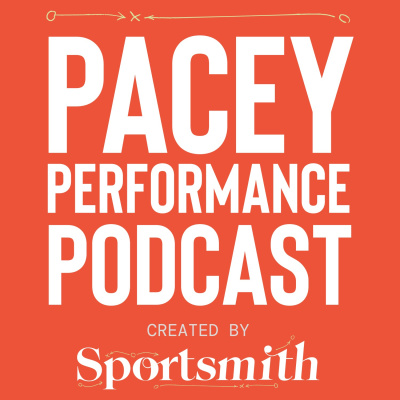Sinopsis
The Pacey Performance Podcast aims to bring together the minds of the best strength and conditioning coaches & sports scientists from the world of professional sport.
Episodios
-
Testing and training deceleration and change of direction qualities with Charlie Faulkner
19/12/2024 Duración: 54minIn this episode of the Pacey Performance Podcast, Charlie Faulkner discusses the critical importance of deceleration and change of direction (COD) in sports performance, emphasizing tailored training approaches and practical experience. Charlie highlights his journey in coaching, where understanding the demands of each game and the specific movement qualities required has been central to his philosophy. Deceleration and COD are essential biomotor qualities that influence high-intensity actions in sports like football and tennis. Effective COD relies on mechanics such as a strong penultimate step and ankle elasticity. Charlie explains how profiling athletes through tools like the modified 505 test, opto jump, and Sprint 1080 provides valuable insights into their movement capabilities and limitations. Video analysis and scoring systems, such as the CMAS scoring system, are used to assess movement mechanics and identify potential injury risks. Charlie emphasizes the importance of evaluating asymmetries, kne
-
Optimising eccentric focused training to run faster and jump higher with Angus Ross
28/11/2024 Duración: 01h04minIn this episode of the Pacey Performance Podcast, Rob is joined by Angus Ross who explores the significance of eccentric training in sports performance and injury prevention, offering insights into its application and benefits. With a background in speed and power sports, Angus shares his journey from an athlete and physiologist to an elite strength coach, emphasizing the importance of hard work and innovative methods in training. Eccentric training, which combines high velocity and force, is highlighted as a critical tool for athletic development. Angus discusses its unique ability to promote muscle fiber adaptations, specifically a shift towards type 2b fibers, which enhance power and speed. However, he cautions that improper management of eccentric training can lead to muscle damage and hinder performance, stressing the need for carefully structured regimens. Innovative devices like flywheel systems are increasingly used to facilitate controlled eccentric loading, particularly in sports requiring spee
-
Enhance athlete performance profiling through MRI with Bryan Heiderscheit, Fearghal Kerin & Emidio Pacecca
21/11/2024 Duración: 57minIn this episode of the Pacey Performance Podcast, Rob is speaking to Bryan Heiderscheit, Fearghal Kerin and Emidio Pacecca. The topic of this conversation is all around MRI and its use in athlete performance profiling. MRI scans are usually thought of an expensive tool that is used when an athlete gets injured. But in this episode we break down those barriers and disciver how they can be used, through technology like Springbok Analytics, in other ways to improve performance and mitigate injury risk with healthy athletes. First we discuss MRI and what it actually is. Bryan gives us some great examples of where it can be used and why. Fearghal and Emidio then give us some amazing insights from the world of elite sport on how MRI scans are actually being used. But most importantly, they give us the real key information which is what we do with the information once we have it. If you're trying to reduce injury risk and optimise performance, check out this episode.
-
Implementing isometric training for performance and rehab with Alex Natera, Danny Lum & Matt Taberner
14/11/2024 Duración: 01h07minIn this episode of the Pacey Performance Podcast, Rob is speaking to Alex Natera, Danny Lum, and Matt Taberner to discuss the role of isometric training in sports performance and rehabilitation, focusing on its ability to enhance strength, recovery, and dynamic performance. Isometric training is increasingly recognized for its utility in sports, especially given the challenge of maintaining effective strength training amidst intense competition schedules. It is effective for improving muscle stiffness, tendon adaptation, and managing recovery, making it essential for injury prevention and rehabilitation. The guests emphasize that isometric training, when paired with plyometric exercises, enhances both muscle and tendon resilience, supporting performance in high-intensity sports. The speakers advocate for using isometric exercises throughout rehabilitation, adjusting the approach to address specific joint weaknesses, and tailoring it to each athlete’s unique needs. For instance, using force evaluations for joi
-
Utilising normative data effectively across different technologies with Luke Fitzpatrick
19/09/2024 Duración: 42minIn this episode of the Pacey Performance Podcast, Luke Fitzpatrick, Head of Data Science at VALD, discusses the role of data science in sports technology and the importance of data quality and security. He explains the process of generating normative data and how clients can get the most out of their data. Luke also shares interesting insights, such as the age at which adolescents experience the largest strength development and the average strength of NFL players compared to the general population. The data science team at VALD is focused on expanding their product suite and providing more valuable insights to clients. This episode is different to any that we have done over the last 10 years. New talking points: The role of a data scientist at Vald Data quality and security Accessing VALD testing data Managing huge amounts of data Visualizing normative data Making the most of your data
-
Injury prevention: Integrating “best practice” to reduce hamstring injuries with Nick van der Horst
11/09/2024 Duración: 46minIn this episode of the Pacey Performance Podcast, Rob is speaking to Rehabilitation Coordinator at PSV Eindhoven, Nick van der Horst. Nick shares his journey from aspiring footballer to sports physiotherapist, where he now focuses on rehabilitation at PSV Eindhoven. Nick advocates for preseason screenings that assess isometric strength, mobility, and contralateral limb function to identify individual risks. He also highlights the importance of iliopsoas mobility for hamstring flexibility and sprint performance. Tailored training strategies and post-game eccentric exercises also play a key role in preventing injuries. Nick emphasizes individualized approaches in both prevention and rehabilitation. Mini-dosing and eccentric training in fatigued states, along with structured recovery phases, help build resilience and reduce injury risk. He also stresses the importance of avoiding ineffective methods like cupping and dry needling in favor of mobility and flexibility work for better energy transfer during athleti
-
Assessing sprint technique - does it even matter? with Johan Lahti
05/09/2024 Duración: 53minIn this episode of the Pacey Performance Podcast, Johan Lahti discusses the complexities of assessing sprint technique in relation to hamstring injury risk. While technology has made sprint assessment more accessible, measuring its impact on injury risk remains challenging, and Johan questions whether it's always worth the effort. However, he emphasizes the importance of focusing on key aspects of technique, such as minimizing time under tension and analyzing movement patterns like overstriding or increased hip flexion, which can lead to hamstring issues. Johan highlights that sprint assessments should consider the entire movement cycle, as isolated 2D assessments may miss critical factors like pelvic movement. He notes that technique assessments do not always predict performance or injury risk accurately, stressing the need to address both movement patterns and physical strength. Strengthening key muscle groups, especially the glutes and hamstrings, is vital for maintaining sprint technique, particularly und
-
Debunking misconceptions about female health and sports performance with Charlie Pedlar
29/08/2024 Duración: 58minIn this episode of the Pacey Performance Podcast, Professor in Sport and Exercise Science, Charlie Pedlar delves into the importance of understanding the unique physiological responses of female athletes to optimize their health and sports performance. He highlights the progress made in recent years, particularly in recognizing the impact of menstrual cycles and iron deficiency on female athletes. Charlie explains that menstrual cycles, which were often overlooked in the past, play a crucial role in influencing athletic performance. Tracking these cycles can help athletes anticipate and manage the physiological changes that occur, allowing for more tailored training approaches. He emphasizes that iron deficiency is prevalent among female athletes due to menstrual blood loss and poor iron absorption, significantly affecting endurance and overall performance. The discussion also covers the challenges of linking individual symptoms to menstrual cycles, as hormonal fluctuations can produce a wide range of ef
-
Its not all about tech: Developing your coaching eye within a speed-based approach to rehab with Alan Murdoch
22/08/2024 Duración: 01h02minIn this episode of the Pacey Performance Podcast, Alan Murdoch discusses the "fast to fit" approach to rehabilitation. Alan advocates for prioritizsng movement assessment over tests, underscoring the value of a strong coaching eye in identifying and addressing underlying issues in athletic movement. This approach allows for more targeted interventions, enhancing the effectiveness of rehabilitation. The "fast to fit" approach focuses on incorporating high-intensity actions early in rehab, aiming to develop necessary coordination and expedite recovery. This contrasts with traditional methods that emphasize building volume before speed, which can delay the athlete's return to peak performance. Frameworks like the Compass Protocol and Prep with Purpose are central to this approach, enhancing decision-making and creativity in fast-paced rehab settings. These frameworks prioritize dynamic warmups, visual assessments, and targeted drills to improve hip mobility, function, and overall athletic performance. Ala
-
Leading a performance department in a multi club ownership structure with Kasper Thornton
15/08/2024 Duración: 49minn this podcast, Kasper Thornton, Group Director of Human Performance at Right to Dream, discusses the complexities and strategies involved in leading a performance department across multiple clubs. He emphasizes a "person-first" approach, where selecting candidates based on mindset, values, and team fit is prioritized over mere technical skills. This approach is crucial in developing a cohesive and effective performance department across multiple clubs, each with its unique culture and challenges. Kasper shares his journey from a physiotherapist to his current leadership role, highlighting the growth of his organization from a small Danish club to a multinational operation with branches in Ghana, Egypt, and San Diego. A significant focus is on building top-notch facilities and developing talent, particularly in the soccer academies associated with these clubs. He outlines the challenges of recruiting and onboarding personnel across different time zones and cultures, stressing the importance of soft skills and
-
Managing T-junction injuries and location based hamstring rehab with Fearghal Kerin
08/08/2024 Duración: 59minIn this episode of the Pacey Performance Podcast, Fearghal Kerin, Rehabilitation Physiotherapist, Chelsea Football Club, discusses the growing prevalence of T-junction hamstring injuries and the importance of location-specific rehabilitation strategies. Fearghal outlines his background, highlighting his PhD focused on hamstring injuries and his work in professional sports, including football and rugby. He emphasizes the evolving role of strength and conditioning coaches in injury rehabilitation and the need for a nuanced approach to managing hamstring injuries based on their anatomical location. Hamstring injuries are classified into sprint-type and stretch-type, with the T-junction—a confluence of the long and short head of the biceps femoris—being particularly susceptible to injury. This area is complex due to its dual force vectors, dual nerve supply, and bi-articular function, making it challenging to rehabilitate. Fearghal discusses the necessity of considering biomechanical positions and sport-spe
-
“Activation” exercises: Are they really improving performance or preparing your athletes? with Gerard McMahon
01/08/2024 Duración: 48minIn this episode of the Pacey Performance Podcast, Gerard McMahon joins us to discuss "activation" exercises and their role in improving performance and preparation. Activation exercises have long been touted for their ability to improve performance by targeting specific muscle groups and maximizing motor unit recruitment. However, Gerard challenges this notion, suggesting that these exercises, often misunderstood and misapplied, may not be as beneficial as many people think. Gerard explains that muscle activation is fundamentally a function of the neuromuscular system, controlled by motor unit recruitment and firing rates. Activation exercises, while intended to improve performance, often do not significantly enhance muscle activation in healthy athletes. Instead, these exercises may be more appropriate for rehabilitation of severe cases or specific disabilities. EMG (electromyography) studies, commonly used to measure muscle activation, have limitations due to the complexity of interpreting muscle signals an
-
Blood flow restriction and its place in the athlete recovery pyramid
04/07/2024 Duración: 01h02minIn this episode of the Pacey Performance Podcast, John Noonan, Warren Bradley, Vasek Jursík and Lucas Baistrocchi discuss the significance of Blood Flow Restriction (BFR) training within the athlete recovery pyramid, highlighting its benefits for improving recovery and performance. BFR training is emphasized as a crucial recovery method, particularly effective when integrated with other modalities. Practitioners are encouraged to consider individual athlete needs, limitations, and evidence-based practices when choosing recovery methods. BFR is praised for its versatility and ease of integration into existing recovery routines. The discussion covers how BFR can enhance nutrient intake, glucose uptake, and muscle recovery, making it a valuable addition to recovery strategies. The guests point out that BFR's simplicity and cost-effectiveness contribute to its growing popularity among athletes and coaches. Positive results from using BFR during workouts and in daily routines are highlighted, with specific
-
PowerBI: Streamlining data analysis, visualisation and communication with Rob Delves
27/06/2024 Duración: 44minIn this episode of the Pacey Performance Podcast, Sports Scientist at the Melbourne Storm rugby league club, Rob Delves discusses the growing use of PowerBI in sports science for data analysis and visualization. PowerBI is becoming a preferred tool over Excel due to its efficiency in handling larger data sets from multiple sources. Rob emphasizes the importance of upskilling in data analysis and communication within sports science, as resources can be limited. PowerBI provides streamlined data management and visualization capabilities, allowing for more advanced data manipulation than Excel. Its easy access, customization options, and cost-effectiveness make it an attractive alternative. Rob highlights that PowerBI offers a uniform platform for data access and management, reducing the need for physical report distribution and potential errors. It integrates smoothly with existing Microsoft Office suites and ensures data security through multi-factor authentication. The transition from Excel to PowerBI is
-
Groin injuries: How to monitor risk and manage rehabilitation with Enda King, Steve Short and Ed Gannon
13/06/2024 Duración: 01h03minIn episode #499 of the Pacey Performance Podcast, Rob is joined by guests Enda King, Ed Gannon, and Steve Short to delve into the intricacies of preventing and managing groin injuries. They emphasize the importance of monitoring and managing training loads, particularly during transitions from pre-season to in-season phases. The discussion highlights the need for regular assessments of range of motion, neuromuscular status, and strength, coupled with close communication with athletic training staff and massage therapists. The conversation covers how groin injuries often stem from asymmetries, stressing the necessity of identifying and managing these imbalances. This includes assessing load, function, and tissue tolerance during rehabilitation, and recognizing that asymmetry can vary by sport and individual. The guests also address the identification of high-risk players and the early warning signs of groin pain. They discuss strategies for mitigating risk, such as investigating markers like range of moti
-
Vertical and horizontal jumping during ACL return to play with Roula Kotsifaki
06/06/2024 Duración: 53minIn this episode of the Pacey Performance Podcast, Rob sits down with Physiotherapist and Head of the Assessment Lab at Aspetar, Roula Kotsifaki to delve into the critical role of technology and specific testing protocols in determining an athlete's readiness to return to play after an ACL injury. Roula emphasizes the importance of measuring asymmetries, movement quality, and strength to prevent future injuries. Key highlights include the construction of sensitive testing protocols to measure key competencies. Roula discusses the significance of hop tests and jump tests in identifying asymmetries and the role of landing variability in ACL rehabilitation. She highlights the use of 3D force plates and cameras to accurately assess power metrics and joint contributions during vertical and horizontal jumps, which are crucial for evaluating an athlete's readiness. Roula also details which metrics we should trust and which we shouldn't, and that includes her questioning the use of rate of force development related me
-
How to use force plates effectively: An expert roundtable with Phil Graham-Smith, Matt Jordan and Paul Read
23/05/2024 Duración: 01h13minOn this episode of the Pacey Performance Podcast, Rob is speaking to 3 experts when it comes to the research and application of force plates, Phil Graham-Smith, Matt Jordan and Paul Read. The converation starts off with Phil diving into how we choose a force plate and what are our options to ensure we are choosing the right technology for our needs. Phil highlights the importance of having a clear objective when selecting force plates, as knowing what and why we are testing is crucial for effective usage. The experts discuss the benefits of using dual force plates for tracking asymmetries in athletes, which is particularly useful in rehabilitation scenarios. This approach not only helps in pinpointing discrepancies but also in enhancing overall performance by ensuring both sides are equally developed. Listeners will also discover the importance of instantaneous feedback and robust data analysis provided by force plate software. Such features are integral for integrating with other measurement devices a
-
Integrating sports science into a college football performance programme with Mitchell Cholewinski
16/05/2024 Duración: 54minIn episode 496 of the Pacey Performance Podcast, Rob is talking to Mitch Cholewinski, Coordinator of Football Sports Science at the University of Nebraska. Mitch starts off with detailing his unusual route into sports science and explains how he applies process dynamics from chemical engineering to manage and optimize athlete training regimens through flowcharts and decision trees. His work at the Nebraska Athletics Performance Lab focuses on biomechanics and sports science, where he has been instrumental in expanding the sports science department. Mitch emphasizes the importance of educating athletes on data collection and the use of new recovery resources like sauna, red light therapy, and sensory deprivation float tanks, ensuring athletes take an active role in their recovery processes. The podcast also covers how Mitch collaborates with strength coaches and integrates with the strength staff to enhance recovery and performance using data-driven methods. He utilizes visual aids and quick communication meth
-
Utilising the sprint mechanics assessment score (S-MAS) to try reduce hamstring injuries with Chris Bramah
09/05/2024 Duración: 01h03minIn this episode of the Pacey Performance Podcast, Rob is speaking to Consultant, Physio and Biomechanist at the Manchester Institute of Health and Performance, Chris Bramah. Delving into the intricacies of running mechanics, Chris explains the crucial connection between specific movement patterns and the risk of hamstring injuries. Through his expertise, listeners gain an understanding of how lumbar-pelvic control, backside mechanics, and overstriding play pivotal roles in athlete health and performance. The conversation further explores the cutting-edge technology of 3D biomechanics assessments, highlighting their application in elite sports environments including Premier League football clubs, to optimize rehabilitation strategies and return-to-play decisions. Chris then introduces the Sprint Mechanics Assessment Score (S-MAS), a novel, simplified tool he developed—a 12-item score that utilizes basic camera setups to assess movement mechanics effectively during athletes' warm-ups. This tool is designed to e
-
Calf injury prevention and rehabilitation with Brady Green
02/05/2024 Duración: 55minIn episode #494 of the Pacey Performance Podcast, Rob is speaking to Senior Lecturer in Musculoskeletal Physiotherapy at the University of Notre Dame, Brady Green for a detailed exploration of calf injuries, particularly their high prevalence and recurrence in elite sports. Brady sheds light on the limited research surrounding the initial risk factors for calf strains, emphasizing the necessity for focused prevention and effective rehabilitation strategies. The conversation begins with an overview of how prevalent calf injuries are in sports like Australian rules football and track and field, noting the challenges in reducing their incidence despite ongoing efforts. Brady points out that older athletes and those with a history of previous calf strains are particularly susceptible to future injuries. He suggests that targeted prevention through high-load strengthening and isometric exercises can induce structural adaptations that help mitigate these risks. The podcast delves into the specifics of screening and














